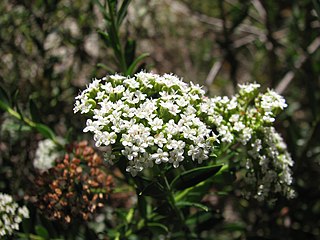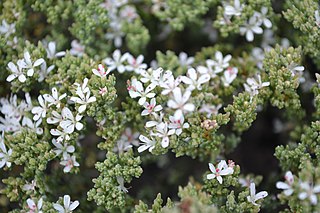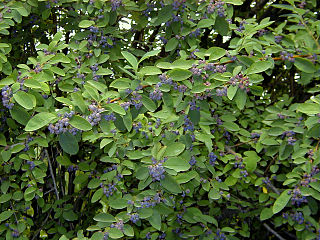
Platysace is a genus of woody perennial herbs and subshrubs in the family Apiaceae. The genus is endemic to Australia.

Hypocalymma is a genus of evergreen shrubs in the myrtle family Myrtaceae described as a genus in 1840. The entire genus is endemic to southern Western Australia.

Robinsonella is a genus of flowering plants in the family Malvaceae. It contains sixteen species of trees occurring from Costa Rica to southern Mexico, eight of which occur in the Mexican state of Chiapas.
Zinowiewia is a genus of flowering plants in the family Celastraceae. It includes 14 species native to the tropical Americas, ranging from northeastern Mexico to French Guiana and Bolivia.
Dictamnus is a genus of flowering plant in the family Rutaceae, native to temperate Eurasia from Spain to China. The genus was first described by Carl Linnaeus in 1753.

Heliocarpus is a genus of flowering plants in the family Malvaceae. It was formerly classified in the Tiliaceae.
Geleznowia is a small genus of flowering plants in the family Rutaceae.

Rinzia is a genus of flowering plants in the family Myrtaceae. The genus was first formally described in 1843 and reinstated and revised in 1986.

Frankenia is the only genus in the Frankeniaceae family of flowering plants. Other genera have been recognized within the family, such as Anthobryum, Hypericopsis and Niederleinia, but molecular phylogenetic studies have consistently shown that they all belong inside Frankenia. Frankenia comprises about 70–80 species of shrubs, subshrubs and herbaceous plants, adapted to saline and dry environments throughout temperate and subtropical regions. A few species are in cultivation as ornamental plants.
The Lophiocarpaceae are a family of flowering plants comprising mostly succulent subshrubs and herbaceous species native to tropical to southern sub-Saharan Africa to western India. It includes the genera Corbichonia and Lophiocarpus. The family is newly recognized through research by the Angiosperm Phylogeny Group III system to deal with long-standing phylogenetic difficulties in placing various genera within the Caryophyllales.

Hermannia is a genus of flowering plants in the mallow family, Malvaceae. It comprises at least 65 species with many more species as yet unresolved.
Aspidonepsis is a genus of flowering plants belonging to the family Apocynaceae.
Basistemon is a genus of flowering plants belonging to the family Plantaginaceae.
Gomphostigma is a genus of flowering plants belonging to the family Scrophulariaceae.
Oligomeris is a genus of flowering plants belonging to the family Resedaceae.

Phlojodicarpus is a genus of flowering plants belonging to the family Apiaceae.
Stenosolenium is a monotypic genus of flowering plants belonging to the family Boraginaceae. The only species is Stenosolenium saxatile.

Zanthoxyloideae is a subfamily of the family Rutaceae.

Cotoneaster acutifolius, the Peking cotoneaster, is a species of flowering plant in the family Rosaceae. It is native to southern Siberia, Mongolia, and most of China, and it has been introduced to Canada, the northern United States, and northern Europe. It is a shrub typically 2–4 m (7–13 ft) tall, found in a wide variety of habitats. Some authorities consider Cotoneaster lucidus, the shiny cotoneaster, to be a synonym of Cotoneaster acutifolius.
Hansenia is a genus of flowering plant in the family Apiaceae, native to from Siberia to China. The genus was first described by Nikolai Turczaninow in 1844.









